Menus
- Sports enduros successfully developed
- Less weight, more central focus
- Development goals achieved
- What’s new? (Four-stroke models)
Motorcycle fair in Milan
EICMA 2019
Presented by

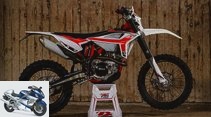
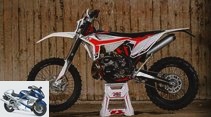
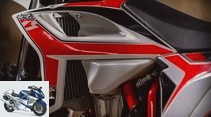
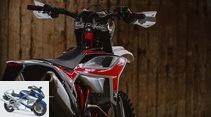
14th photos
to the video
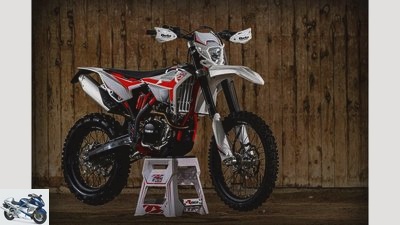
Marco Campelli
1/14
Inspired by the great success that Beta was able to achieve in the EnduroGP, the long-awaited sweeping blow in the further development of the “RR” sport enduros took place with the Italians.
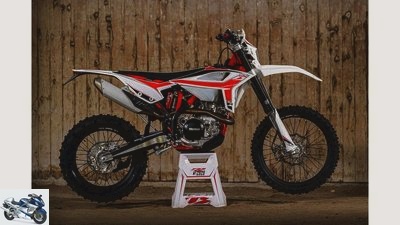
Marco Campelli
2/14
For the 2020 model year there were not only new clothes in the form of a completely new bodywork,…
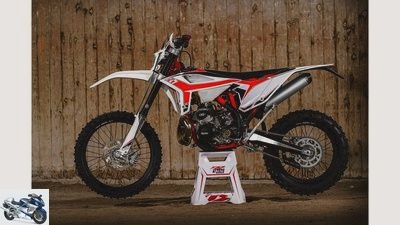
Marco Campelli
3/14
… Instead, the four four-stroke enduros received completely new engines and frames.
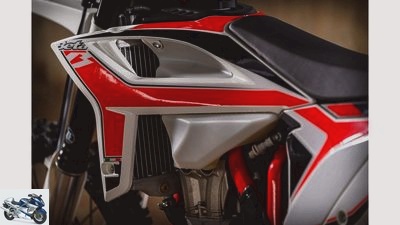
Marco Campelli
4/14
The new plastic parts not only look like they are made of one piece, …
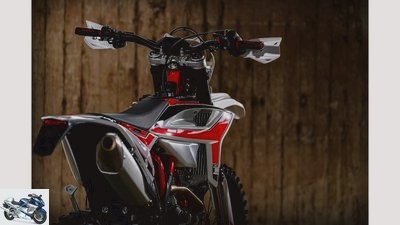
Marco Campelli
5/14
… You can also move very well on the new betas in practice.
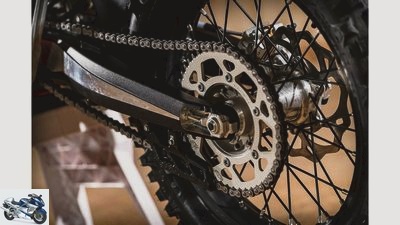
Marco Campelli
6/14
The rear swing arm has been lengthened.
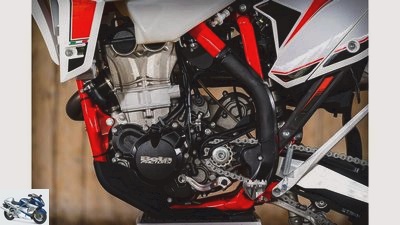
Marco Campelli
7/14
The four-stroke models have got a new engine housing.
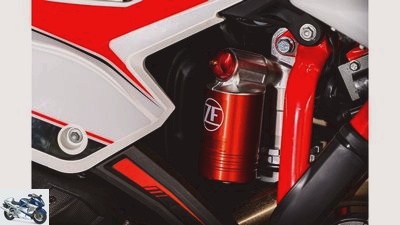
Marco Campelli
8/14
The ZF Sachs chassis components have also been revised.
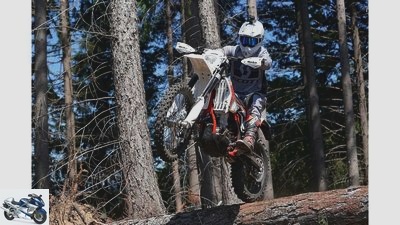
Marco Campelli
9/14
The engines impressed with a soft response and a very easy to control, linear power development.
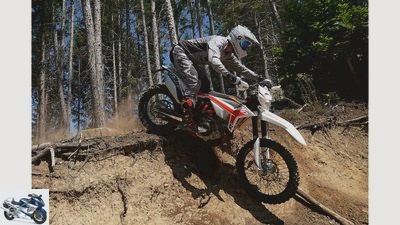
Marco Campelli
10/14
The 350 cc engine is the most revving and the motorcycle is the handiest of the four four-stroke engines.
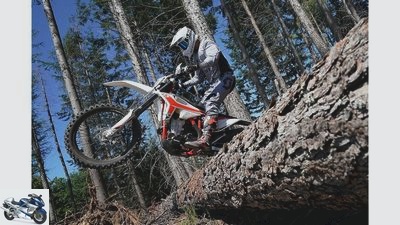
Marco Campelli
11/14
It is amazing how easy it is to drive the big engines and how well the bikes act in the field.
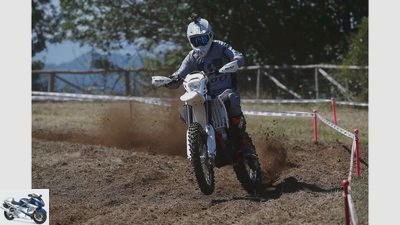
Cristiano Moreno
12/14
The new plastic parts offer a good contact surface for the body without restricting the flow of movement.
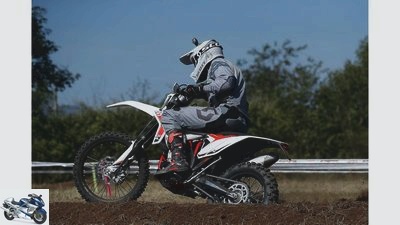
Cristiano Moreno
13/14
The chassis is in the basic set-up on the comfortable side and responds finely over stones and roots.

Cristiano Moreno
14/14
If you prefer a fast pace, you have to turn the adjustment wheels for the compression and rebound damping to find a suitable setting.
Beta Enduro RR 2020 in the driving report
Sports enduros successfully developed
Inspired by the great success that Beta was able to achieve in the EnduroGP, the long-awaited sweeping blow in the further development of the “RR” sport enduros took place with the Italians.
They say “never change a winning team”, but when developing sports enduro bikes you shouldn’t rest too long on won laurels, because the competition never sleeps. At B.In the past, eta has focused on finding the right balance between further development and stability. But for the 2020 model year there were not only new clothes in the form of a completely new bodywork, but the four four-stroke enduros also received completely new engines and frames. More precisely, almost everything has been revised, including the ZF Sachs chassis components, the rear frame, the swing arm, the cooling system and even the side stand.
Less weight, more central focus
The new plastic parts not only look like they are made from one piece, but you can also move very easily on the new betas in practice. The motorcycles are slim, edges that you sometimes got stuck on with your boots in the past have been removed or smoothed and thanks to the particularly flat tank bench line you can sit right up to the front.
Marco Campelli
When developing the new frame geometry, the aim was to move the motorcycle’s center of gravity further back towards the center of the motorcycle. To accomplish this, a longer swing arm was also given, in which the rear wheel was positioned further back. Mass centralization also became one of the main topics in the development of the new engine housing for the four-stroke models, which are available with displacements of 350, 390, 430 and 480 cm³. Compared to the previous engine, the clutch has moved further upwards, while the crankshaft has moved backwards. The new transmission has become shorter, smaller and lighter. Overall, the new engines have slimmed down around 1 kg.
Development goals achieved
On the route, the machines were able to confirm the advance praise of the engineers. The new plastic parts offer a good contact surface for the body without restricting the flow of movement. The flat bench line was particularly noticeable, allowing you to take a seat at the front even for the tightest of U-turns. The engines impressed with a soft response and a very easy to control, linear power development. One of the development goals was to make the motorcycles fun and easy to drive. Mission accomplished! The 350 cm³ engine is the most revving and the motorcycle is the handiest of the four four-stroke engines. The 480 is naturally the motorcycle with the most torque and pulling power, but also the least manageable. Still, I was thrilled by how easy it was to drive the big engines and how well the bikes acted off-road.
The chassis is in the basic set-up on the comfortable side and responds finely over stones and roots. If you prefer a fast pace, you have to turn the adjustment wheels for the compression and rebound damping to find a suitable setting.
The motorcycles will be available from beta dealers from the end of July.
What’s new? (Four-stroke models)
engine
- Engine housing new, clutch and ignition cover made of magnesium (engine 1 kg lighter in total)
- The clutch moves up, the crankshaft moves backwards (closer to the center of gravity of the motorcycle)
- Water pump more powerful
- Clutch linings changed (better controllability)
- Circuit changed (shorter shift travel, more precise actuation)
- Secondary ratio shorter (only RR 430/480)
landing gear
- Rear frame made of plastic (technopolymer)
- Plastic cladding slimmer
- Swing longer
- Frame geometry trimmed for better handiness
- Fork and shock absorber (both from ZF) retuned
- Seat more comfortable
- Tank larger (9.1 l)
Prices
RR 350 EFI 9,290 euros (2019: 8,990 euros); RR 390/430/480 EFI 9,390 euros (2019: 8,990 euros)
Related articles
-
Honda CRF 1100 L Africa Twin (2020) in the driving report
Motorcycle fair in Milan EICMA 2019 Presented by Honda 14th photos Honda 1/14 The base model Honda CRF 1100 L Africa Twin comes exclusively with the…
-
Beta sport enduro models of the 2017 model year in the driving report
Beta 14 pictures Beta 1/14 Unusual: Ironically, an Italian manufacturer doesn’t use Brembo brakes. But Nissin’s retarders …
-
Enduro comparison – off-road bikes from Beta, Honda, Yamaha and KTM
Monnich 24 pictures Monnich 1/24 With the Freeride 350, KTM is taking responsibility for the off-road scene. The competition: Yamaha WR 250 R, Honda CRF 250 L, …
-
Beta RR 350 EFI 2015 in the driving report
Beta 13 pictures Beta 1/13 While all off-road machine manufacturers have long since switched to gasoline injection for their four-stroke engines, …
-
Driving report Quad KTM 450 XC against Enduro KTM 450 EXC-R
Paulovits Driving report Quad KTM 450 XC against Enduro KTM 450 EXC-R Trace search Up to now, single-track off-road vehicles have been the domain of KTM….
-
Driving report Beta RR Enduro 450 4T
Driving report Beta RR Enduro 450 4T Out of Austria Actio equals reactio, every force creates a counterforce, the physicist Isaac Newton recognized …
-
BMW S 1000 RR (2019) in the driving report
BMW 26 pictures BMW 1/26 Anyone who opts for the M package has to invest 22,250 euros. BMW 2/26 The base price is 18,750 euros. BMW 3/26 …
-
MV Agusta F3 RC and MV Agusta F4 RC in the HP driving report
MV Agusta 25 pictures MV Agusta 1/25 MV Agusta offers the WM-basic models for sale with the limited models F3 RC and F4 RC. Looking good is enough …
-
Driving report Radical Guzzi Ristretto 1380
14th photos Rossen Gargolov 1/14 What a transformation: the 1400 V2 of a current California implanted in a classic Tonti frame….
-
Driving report KTM EXC 400-520 Racing
Driving report KTM EXC 400/520 Racing Raise your cups Reason to celebrate? Why, surely. With the 400 and 520 Racing, KTM achieved the coup of this…